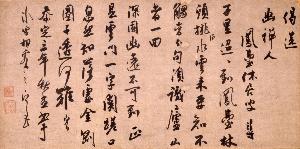Qingmao Gulin
Qingmao Gulin;Gulin Qingmao
Place: Leqing
Born: 1262
Death: 1329
Biography:
Early Life and Training
Gulin Qingmao was known for his powerful calligraphic style and is considered to be the most distinguished Zen calligrapher. He is considered to be part of the Wanshi-ha poetry movement, based on the writing style of the Sōtō monk-poet Hongzhi Zhengjue. Gulin Qingmao died in 1329. Artistic Style and Contributions
Gulin Qingmao's artistic style is characterized by his use of bold and expressive brushstrokes, which reflect the intensity and emotion of his spiritual practice. His calligraphic style is highly regarded for its beauty and elegance, and is considered to be a model for later generations of artists.
Legacy and Impact
Gulin Qingmao's legacy extends beyond his own artwork, as he has influenced generations of artists and calligraphers. His contributions to the Wanshi-ha poetry movement have had a lasting impact on the development of Chinese literature and art. Important works by Qingmao Gulin include his Chinese Farewell Verse, which is considered an important cultural property. This painting, measuring 68 x 34 cm, is a testament to Qingmao Gulin's skill in Chinese calligraphy and is currently housed at the Fukuoka Art Museum in Fukuoka, Japan. Qingmao Gulin: Chinese Farewell Verse (Important Cultural Property) is a stunning example of Qingmao Gulin's artwork, and can be viewed on Wikioo.org.

